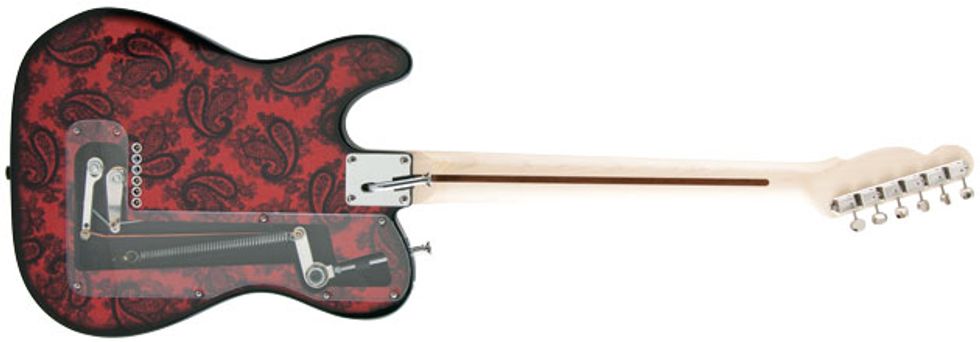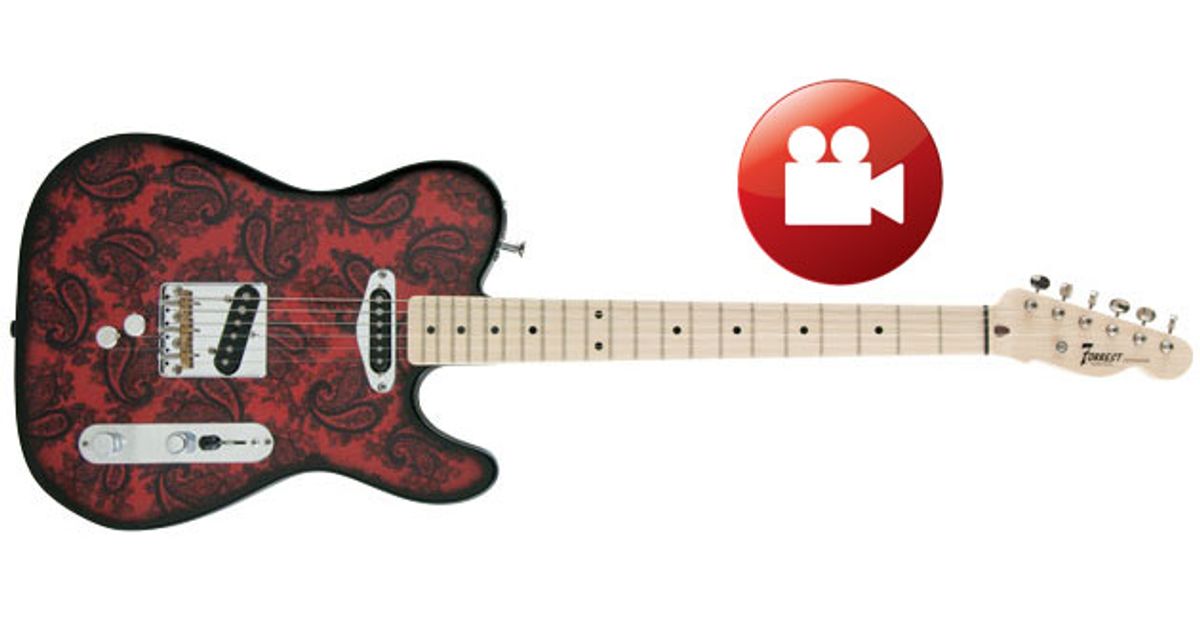Double-bender T-style delivers seemingly infinite tones and textures.
The Forrest DB Boost B and G Bender is a string bender’s dream.
For the uninitiated: “Bender” guitars employ internal springs and levers to bend individual strings up to a fixed pitch. Typically, the Bstring is raised a whole step by pulling down against the guitar strap. This tugs the upper-bout strap button through a routed slot, triggering a mechanism that runs through the body to the bridge area, where it raises the string’s pitch.
This ingenious device can also be attached to the G string. Sometimes the strap button controls the B string, while a lever near the neck plate controls the G string. This second lever is attached to a lanyard hooked on the player’s belt, so that pushing the guitar away from the player’s body raises the pitch. This is called a double-bender guitar.
Clarence White, Albert Lee, Jimmy Page, and Ricky Skaggs have all used B-bender guitars to amazing ends. Brad Paisley uses a G bender. Jimmy Olander of Diamond Rio rocks an instrument fitted with both. The DB Boost B and G Bender is for players like Olander, for whom one bender is not enough.

Enchanted Forrest
Forrest Lee Jr., is a monster Tele picker who built his first guitar when he was 12 and started making benders when he was 18. He and his wife, Cheryl, operate Forrest Custom Guitars. They specialize in custom guitars and parts and bender installations.
Our review instrument boasts every bell and whistle the company offers save for custom binding. It has a urethane red sparkle/black paisley finish with a black burst beautifully applied to both its front and back. The light swamp ash body and aluminum bender mechanism keep the weight down around the Les Paul range, as opposed to the boat-anchor heaviness of many bender guitars.
The one-piece maple neck sports a skunk stripe, a rolled ’60s C shape, and a smooth urethane finish. The well-rounded medium frets provide low and speedy yet buzz-free action. The frets feel a little rough in spots when rubbing my hand and along their edges, but not while playing. The three-saddle brass bridge is compensated. Intonation is accurate. The guitar rings in tune, free from discordant overtones.
The guitar’s high-end electronics include pickups from Jeff Callahan hand-wound to FCG specs and wired to provide a 2 kHz bump when you pull up the tone pot. There’s also a Turnstyle switch system by Michael Franklin, which employs a three-way switch and a Fender S1 volume pot. Pushing in the top of the volume knob changes the stock pickup setting to three alternate sounds.
Ratings
Pros:
Well built. Many tones. Wonderful playability.
Cons:
Slightly rough fret ends.
Tones:
Playability:
Build/Design:
Value:
Street:
$4,500
Forrest Custom Guitars DB Boost B and G Bender
forrestcustomguitars.com
Bendable Twang Beast
I tested the guitar through a Little Walter 50-watt head and a Fender Blues Junior. With the boost off, the bridge pickup delivered vintage country twang, while the neck proffered enough bite for blues. Pulling the tone pot leaves the guitar sounding twangy enough, but more modern and Gibson-like. With the switching system activated, the bridge position becomes the bridge and neck pickups in series, the middle position provides a darker-sounding two-pickup blend, and the neck position turns on the bridge pickup alone with a cocked wah-like filter, perfect for driving distortion and replicating the Dire Straits “Money For Nothing” tone.
Rounding the Bend
Playing a double-bender guitar requires a different mindset. After years of emulating pedal steel parts without a bender, I had to resist the urge to produce pedal steel-type lick with my fingers alone. That said, I was exploring Clarence White and Albert Lee B-bender licks in no time. Meanwhile, the G bender reminded me that bending up a whole step on the 3rd string while holding a note on the 4th string is a heck of lot easier with a bender than with your fingers.
Using the two benders together takes concentration. At times the trick is to avoid bending the B or G strings slightly out of tune during normal playing—you have to be careful about leaning on the neck or gesturing too wildly. But once mastered, the two-bender system lets you perform moves that would be nearly impossible on a regular 6-string. (Example: Start with the B or G string bent, then release that string while raising the other.) You can also explore more unusual sounds by setting the bender range to half steps or other intervals via the Allen screws near the neck plate.
The Verdict
Even without the benders, this would be a beautiful, terrific-sounding, and super-playable guitar that provides a whopping 12 tones from two pickups. With the benders on board, it can mimic a pedal steel and create a cornucopia of sliding harmonics that can spice up styles well outside the country genre.
Watch the Review Demo:

